
A. INTRODUCTION
B. SUPERINTENDENT'S COMPENDIUMIn accordance with regulations and the delegated authority provided in Title 36, Code of Federal Regulations (“36 CFR”), Chapter 1, Parts 1-7, authorized by Title 54 United States Code, Section 100751, the following provisions apply to all lands and waters administered by the National Park Service, within the boundaries of Chattahoochee River National Recreation Area. Unless otherwise stated, these regulatory provisions apply in addition to the requirements contained in 36 CFR, Chapter 1, Parts 1-7. Written determinations, which explain the reasoning behind the Superintendent’s use of discretionary authority, as required by 36 CFR, Section 1.5(c), appear in this document identified by italicized print. 36 CFR §1.4 - DefinitionsThe term "park" means the waters of the Chattahoochee River, to the maximum extent of the high water mark (“bank-to-bank”), from Buford Dam to its confluence with Peachtree Creek and the land along it as defined in the park’s enabling legislation with revisions as indicated on authorized land maps. The term "unmanned aircraft" means a device that is used or intended to be used for flight in the air without the possibility of direct human intervention from within or on the device, and the associated operational elements and components that are required for the pilot or system operator in command to operate or control the device (such as cameras, sensors, communication links). This term includes all types of devices that meet this definition (e.g., model airplanes, quadcopters, drones) that are used for any purpose, including for recreation or commerce. The Term “Bicycle” means every device propelled solely by human power upon which a person or persons may ride on land, having one, two, or more wheels, except a manual wheelchair. The Term “Electric Bicycle” means a two- or three-wheeled cycle with fully operable pedals and an electric motor of not more than 750 watts that meets the requirements of one of the following three classes: (1) “Class 1 electric bicycle” shall mean an electric bicycle equipped with a motor that provides assistance only when the rider is pedaling, and that ceases to provide assistance when the bicycle reaches the speed of 20 miles per hour. (2) “Class 2 electric bicycle” shall mean an electric bicycle equipped with a motor that may be used exclusively to propel the bicycle, and that is not capable of providing assistance when the bicycle reaches the speed of 20 miles per hour. (3) “Class 3 electric bicycle” shall mean an electric bicycle equipped with a motor that provides assistance only when the rider is pedaling, and that ceases to provide assistance when the bicycle reaches the speed of 28 miles per hour. 36 CFR §1.5 - Visiting Hours, Public Use Limits, Closures, and Area Designations For Specific Use Or ActivitiesThe following visiting hours and public use limits are established for all or for the listed portions of the park, and the following closures are established for all or a portion of the park to all public use or to a certain use or activity: (a)(1) Park Hours - The park is closed to all visitor use during the hours of darkness, except under conditions of a permit issued by the Superintendent. Darkness is defined as thirty (30) minutes after local sunset to thirty (30) minutes before local sunrise. (a)(1) Hewlett Lodge Visitor Center Closure – The visitor center is closed to the public annually on Thanksgiving and Christmas Day. The park area contains no developed overnight accommodations, nor does it contain any facilities that are normally used at night. It is therefore felt that no legitimate public activity would be prevented by closing the park at night. The legislated purpose of the park would not normally be served by night use. (a)(1) Motorized Vessels Closure - The following park waters are closed to motorized vessels, all year:
A vessel with a motor is considered in compliance with the closure if the motor is removed from the transom, or other attachment point from which it is operated, and placed in the bottom or on the deck of the vessel. These prohibitions and restrictions are necessary for public safety and resource protection. (a)(1) Closure of Glass containers - The Chattahoochee River National Recreation Area is closed to glass beverage containers; the possession of glass beverage containers is prohibited except:
The restriction on glass beverage containers is based on safety and environmental concerns. Glass beverage containers are not appropriate at Chattahoochee River National Recreation Area, as the number of injuries related to this type of container continues to be an issue. Based on this concern, the National Park Service has closed the above areas to glass beverage containers. (a)(1) Unmanned Aircraft, Rockets, Vessels and Vehicles Closure – The park, including airspace, is closed to the launching, landing, or operating of unmanned aircraft, rockets, vessels, vehicles or similar propelled devices. Launching, landing, or operating an unmanned aircraft, rocket, vessel, vehicle or similar propelled device from or on lands and waters administered by the National Park Service within the boundaries of Chattahoochee River NRA is prohibited except as approved in writing by the superintendent. Unmanaged or unrestricted recreational use of unmanned aircraft within Chattahoochee River National Recreation Area will conflict with, or impact, a variety of park uses including visitor experience of unimpaired view sheds; the disturbance, displacement or harassment of park wildlife to include threatened and endangered species present potential for impacts or damage to sensitive thermal areas; creation of public safety hazards per operation near roadways or large aggregations of visitors, and visual or aural impacts to wilderness character and values within the park backcountry. Less restrictive measures were not considered sufficient due to the rapidly expanding and evolving use of UAs throughout the world. Section 1.5 of NPS Management Policies 2006 provide that a new form of park use may be allowed within a park only after a determination has been made by the park Superintendent that it will not result in unacceptable impacts on park resources and values. (a)(1) Trail Games Closure - The park is closed to the playing of hash house harrier games. The painting, flagging, or dropping of materials for the use of marking a trail or path is prohibited. This activity is prohibited based upon potential negative impacts on natural and cultural resources. The negative impacts of concern include: painting, flagging, or dropping of materials. (a)(1) Geocaching Closure - The park is closed to the establishment of geocaches. This is prohibited activity based upon potential negative impacts on natural and cultural resources. The negative impacts of concern include: digging holes to bury caches, manipulating vegetation and geological formations to conceal caches, and the creation of unauthorized social trails. (a)(1) Island Ford Administrative Areas Closure – The Island Ford Administrative areas are closed to public use. Non-employees doing business with the park may enter and remain in these areas when invited and escorted by park staff. Delivery company personnel may enter these areas when making deliveries or pick-ups. The following areas are closed:
This area is closed to public access to protect the privacy and security of park employees. (a)(1) Settles Bridge – The NPS portion of Settles Bridge structure is closed to public use. The following restrictions and/or conditions are in effect for the specific uses or activities noted: (a)(2) Wearing of Masks While on Park Property - When the COVID-19 Community Level is LOW or MEDIUM in the county or all the counties where the park is located based on data provided by the Centers for Disease Control and Prevention (CDC), individuals are not required to wear masks. When the COVID-19 Community Level is HIGH in the county or all the counties where the park is located based on data provided by the CDC, all individuals over the age of two must wear masks, regardless of vaccination status, in all common areas and shared workspaces in buildings owned, leased, or otherwise controlled by the National Park Service, including, but not limited to, park visitor centers, administrative offices, lodges, gift shops and restaurants. When the COVID-19 Community Level is HIGH in one or more, but not all, of the counties where the park is located based on data provided by the CDC, the superintendent will determine whether individuals are required to wear masks. The requirement, if any, will apply to all facilities within the park. Masks must cover the nose and mouth and fit snugly around the nose and chin with no large gaps around the sides of the face. Masks not designed to be protective, masks with ventilation valves, and face shields do not meet the requirement. Regardless of the COVID-19 Community Level, individuals may wear masks if they choose to do so. Where a state, local, tribal, or territorial government where the park is located imposes more protective mask-wearing requirements than those indicated by the COVID-19 Community Level, individuals must follow those more protective requirements within the park. More protective state, local, tribal, or territorial mask-wearing requirements are hereby adopted as federal requirements in all units of the National Park System located within that state, locality, area subject to a federally recognized Indian tribe’s regulatory jurisdiction, or territory, regardless of a particular park’s jurisdictional status. Additionally, all individuals must wear masks in or on public transportation conveyances and transportation hubs/facilities, to the extent required by current orders or directives issued by the CDC, the Transportation Security Administration (TSA), or other federal agencies with jurisdiction over those conveyances or areas. As of March 4, 2022, CDC and TSA orders or directives require all individuals regardless of vaccination status to wear masks in indoor areas of all forms of public transportation conveyances, including busses, trains, and boats/ferries, and in the indoor premises of transportation hubs/facilities. Individuals are not required to wear masks while outdoors on conveyances or while outdoors on the premises of transportation hubs/facilities. (a)(2) Motorized Wheelchairs and Personal Transporters - Motorized wheelchairs and other “power-driven mobility device" (OPDMD) personal transporters are allowed on trails where bicycle and E-Bikes are authorized when used by persons with mobility disabilities. Any OPDMD must abide by all laws pertaining to E-bikes. (a)(2) Personal Flotation Devices – A wearable personal flotation device (PFD) must be worn at all times by each person boating, tubing, or wading in Chattahoochee River waters between 1) Buford Dam and the Highway 20 bridge; and 2) Morgan Falls Dam and the Morgan Falls boat ramp. Children under the age of 13 must wear a PFD when aboard a vessel that is under way in the Chattahoochee River or ponds, unless the child is within a fully enclosed cabin. On all other river sections in the park, a PFD is required for each person aboard a vessel or tube in the Chattahoochee River or ponds and highly recommended that it be worn. PFDs must be: Readily accessible to all occupants when not worn. In good and serviceable condition. Legibly marked with the US Coast Guard approved number. Appropriately sized for the occupants. (a)(2) Park Passes – Park passes are available in digital and physical form Drivers of vehicles that park in designated parking lots identified by entrance fee signs are required to purchase and properly display a daily or annual park pass if applicable. (a)(2) Digital Passes – Daily and Annual Park digital passes are associated with the registration tag of each vehicle (one digital pass per vehicle), a separate digital Park pass must be purchased for each parked vehicle. (a)(2) Physical Passes – Daily, Annual, Senior, Interagency, Access, Military, 4th and 5th grade passes may be purchased and transferred from vehicle to vehicle. Physical passes must be displayed hung from the rear-view mirror facing the windshield, displayed on the dashboard in a visible outward facing state, or taped to the inside of the windshield. An annual park pass internet sales receipt is valid for 10 days when displayed on the dash of the vehicle. Other annual park pass receipts are not sufficient and do not satisfy the display requirement of this section. (a)(2) River Watercraft Access - All vessels; including tubes, rafts, canoes, kayaks, paddleboards; may only access the river at public access launch ramps. These ramps are located at:
36 CFR §1.6 - Activities That Require A Permit(a) Special Use Permit Limits - Special Use Permits may be issued no earlier than one hundred twenty (120) days prior to the start of the permit. No one organization or group may reserve the same area more than three (3) consecutive weekends or nine consecutive days in any thirty (30) day period. (f) The following is a compilation of those activities for which a permit from the superintendent is required: The following activities require a permit:
Part 2 - Resource Protection, Public Use and Recreation36 CFR §2.1 - Preservation of Natural, Cultural and Archeological Resources(c)(1) The gathering, by hand, of native and non-native fruits, berries and nuts for personal use or consumption is allowed. Each gatherer is allowed one (1) gallon, per day. Sale or commercial use of gathered fruits, berries and nuts from Chattahoochee River National Recreation Area is strictly prohibited. Gathering of plants or mushrooms is also strictly prohibited, unless authorized by permit. (c)(2)(ii) The use of ladders or climbing of vegetation is prohibited while gathering native and non- native fruits, berries and nuts. All collections must be accomplished while within reach of the ground. 36 CFR §2.2 - Wildlife Protection(d) It is prohibited to transport lawfully or unlawfully taken wildlife with the exception of lawfully fish and as outlined below. (d) Lawfully taken wildlife outside of the park that escapes in to the park may be pursued and retrieved only when first receiving permission from the Chief Ranger. Persons pursuing or retrieving lawfully taken wildlife may not bring weapons as defined in 36 CFR into the park. (d) Lawfully taken wildlife may be transported on state and county roadways without obtaining permission or a permit from the Superintendent. (e) The park is closed to the viewing of wildlife with an artificial light. CFR §2.10 - Camping and Food Storage(a) A permit is required from the Superintendent in order to camp overnight. 36 CFR §2.13 - Fire(a)(1) Fires may be lighted and maintained without obtaining a permit from the Superintendent when the fire is contained in a grill or other suitable container designated for such use. (b) Fires shall be extinguished upon termination of use to the extent that no hot coals, ash or burnt materials remain. Cold coals, ash and burnt materials shall be deposited in metal trash receptacles or removed from the park. 36 CFR §2.14 - Sanitation and Refuse(a)(8) In developed and front country areas, human body waste may only be disposed of in restroom toilet and urinal fixtures designed for that purpose. 36 CFR §2.15 - Pets(a)(5) Individuals in possession of pets must have on their person a bag or device for the containerization and removal of pet excrement. Individuals shall immediately containerize and dispose of excrement deposited by their pet in a trash receptacle or remove it from the park. This section shall not apply to individuals in possession of horses utilizing designated equestrian trails. (e) Pets may not be kept by park residents unless written approval is obtained from the Superintendent. 36 CFR §2.16 - Horses and Pack Animals(b) Horses are only permitted on the designated equestrian trails located on the Forsyth County side of Bowman’s Island. 36 CFR §2.51 - Public Assemblies(e) First amendment areas Locations are designated in Appendix A or online at: https://www.nps.gov/chat/learn/management/superintendents-compendium.htm#AppendixA 36 CFR §2.52 - Sale or Distribution of Printed Matter(e) First Amendment areas are designated in Appendix A or online at: https://www.nps.gov/chat/learn/management/superintendents-compendium.htm#AppendixA Part 4 - Vehicles and Traffic Safety36 CFR §4.11 - Load, Weight, and Size Limits(a) A permit is required from the Superintendent in order to operate a vehicle exceeding designated load, weight and size limits. Vehicles exceeding designated load, weight and size limits that are operating on state and county roadways may do so without obtaining a permit from the Superintendent. 36 CFR §4.21 - Speed Limits(b) The following maximum speed limits are designated for the following roads and trails:
36 CFR §4.30 - Bicycles and E-bikes(See definition in section 1.4) (a) Bicycles are allowed on all paved and unpaved roads and parking areas open to public vehicle traffic.(a) Bicycles are allowed on unpaved roads closed to public vehicle traffic and trails that are identified with posted bicycle permitted symbolic signs and located in the following areas: Cochran Shoals. These bicycle routes located within Cochran Shoals are identified on a map in Appendix B. (a) Bicycles are allowed on the following surfaced multi-use trails: Riverside trail located adjacent to Ivy Mill, West Palisades along the Bob Callan Trail adjacent to Rottenwood Creek, Cochran Shoals along the fitness loop and the designated bike trails in the Sope Creek area. (a) All other unpaved park roads closed to public vehicle traffic are closed to bicycles. (a) Bicycle users must follow the directional one-way signs on the Cochran Shoals multi-use trails. (a) Bicycle users must yield to pedestrians when encountered on multi-use trails. (i) Electronic Bicycles
(i) Taking into consideration public health and safety, natural and cultural resource protection, and other management activities and objectives; and
(ii) Notifying the public through one or more methods listed in 36 CFR 1.7, including in the superintendent’s compendium (or written compilation) of discretionary Appendix ALocations Designated for §2.51 Public Assemblies and §2.52 Sale or Distribution of Printed Matte 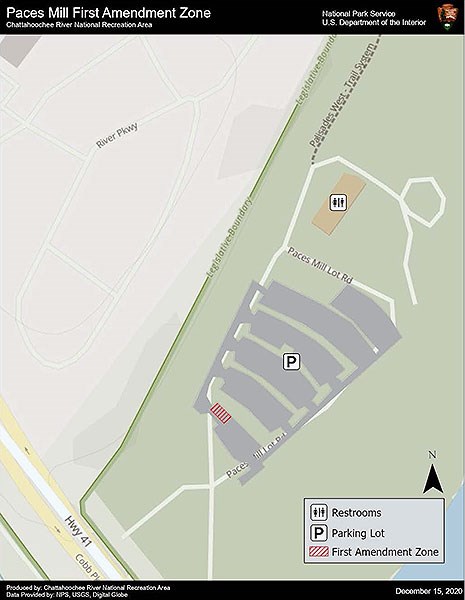
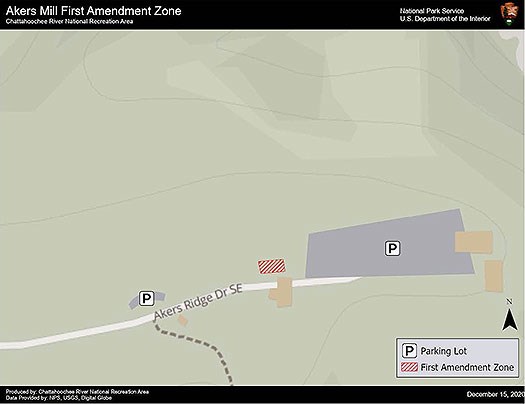
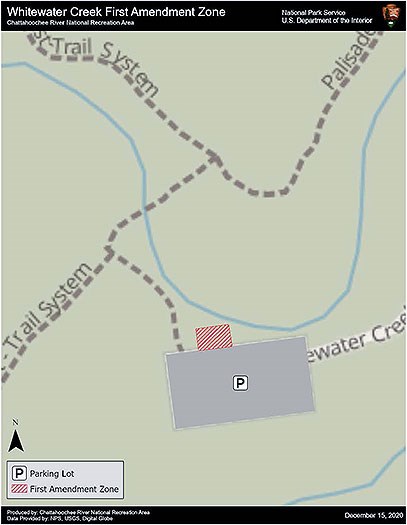
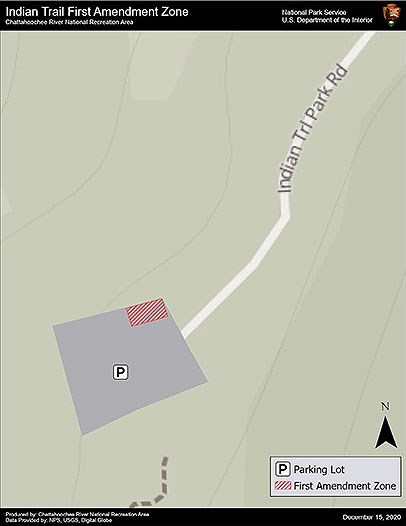
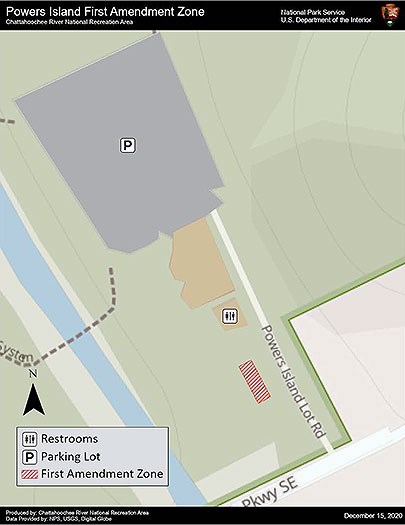
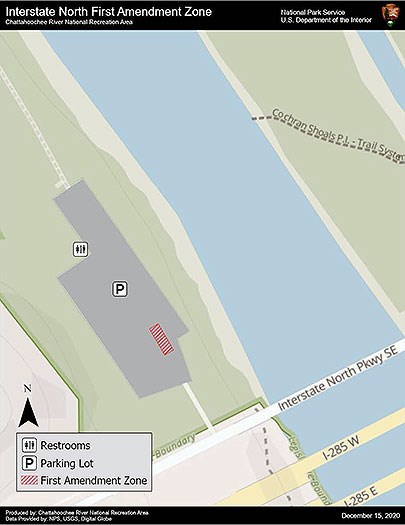
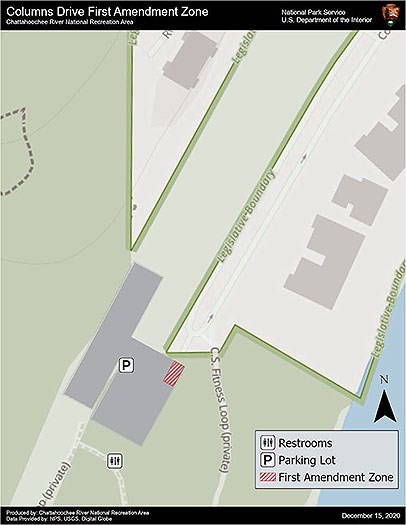
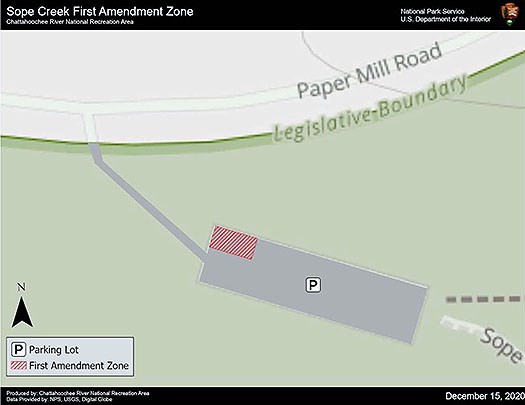
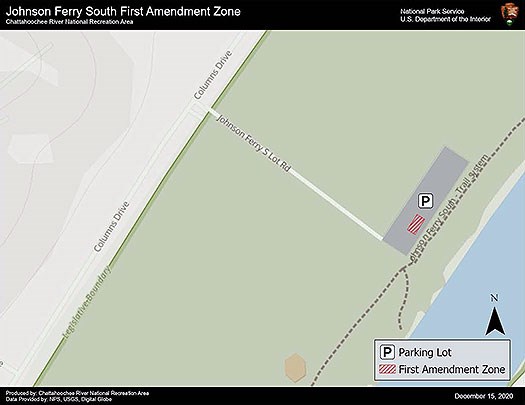
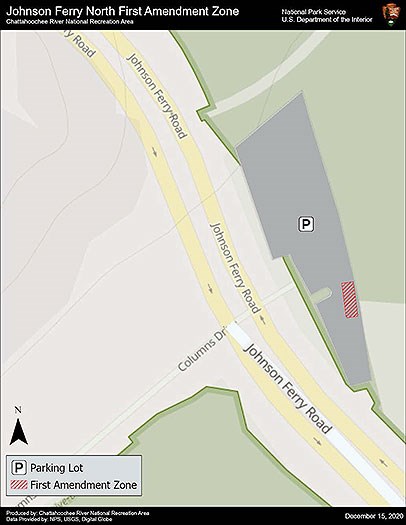
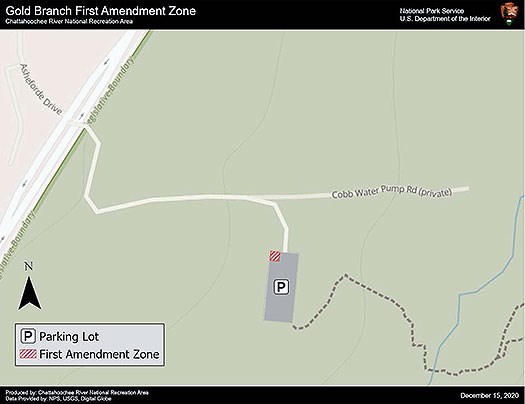
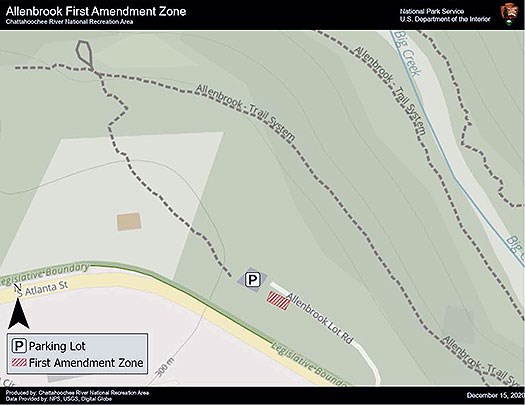
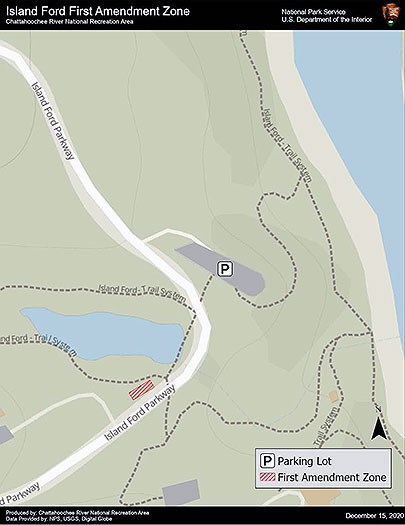
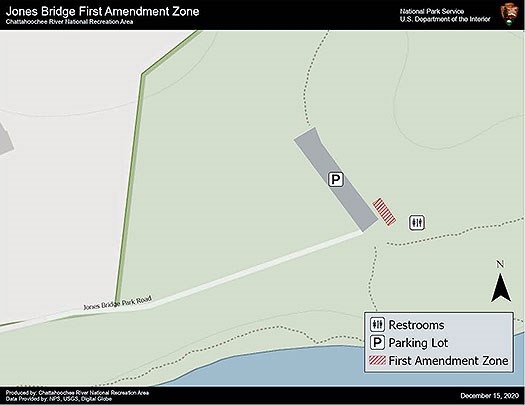
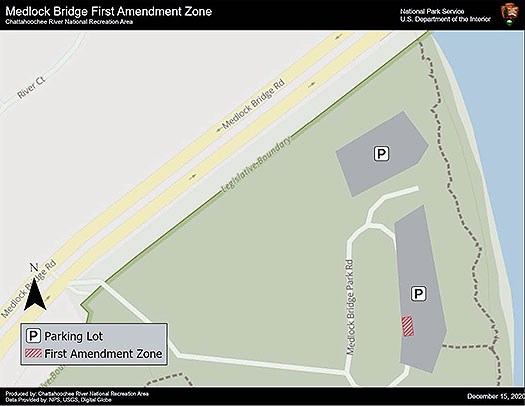
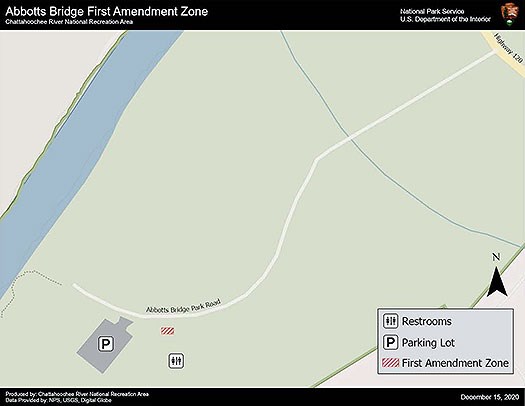
Appendix BCochran Shoals Bicycle Route Map 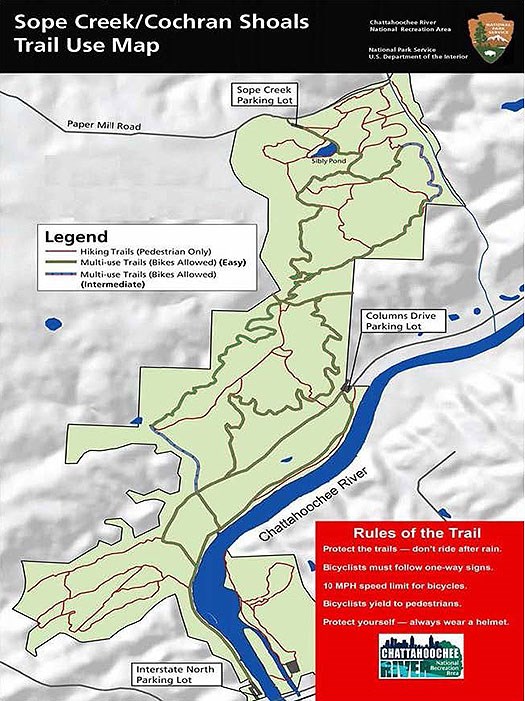
|
Last updated: November 18, 2022
